Monday, Apr. 14 & Tuesday, Apr. 15 with John A. Gladysz & Janet Bluemel
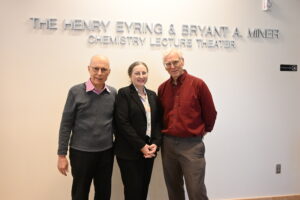
In 2016, the Department of Chemistry hosted the inaugural Robert W. Parry Lectureship in Inorganic Chemistry. This annual lecture recognizes Distinguished Professor Bob Parry, one of our most notable former faculty members. Prof. Harry delivered the first lecture.
Gray, a world-class inorganic chemist from CalTech, a friend of Bob Parry’s, and a donor to the fund. Marjorie Parry and other family members are also the attendees and supporters of the Parry Lecture.
Distinguished Professor Robert W. Parry was a giant in his profession. He was the founding editor of Inorganic Chemistry in 1960. He served as the President of the American Chemical Society in 1982, won the first Utah Governor’s Medal in Science and Technology in 1987, and received the American Chemical Society’s Priestley Medal in 1993.
In his 60-year career, Bob taught thousands of undergrads and mentored over 60 Ph.D. students and postdocs.
Together with Henry Eyring and Cheves Walling, Bob played a key role in the growth and development of chemistry at Utah.
The 2025 Parry Lecture was held on April 14 and 15, 2025. The speakers were John A Gladysz, Texas A&M University, and Janet Bluemel, Texas A&M University.
John A. Gladysz
John A. Gladysz is a native of the Kalamazoo, Michigan area. He obtained his B.S. degree from the University of Michigan (1971) and his Ph.D degree from Stanford University (1974) with E. E. van Tamelen. He subsequently held appointments at UCLA (Assistant Professor, 1974-1982), the University of Utah (Associate Professor and Professor, 1982-1998), and the University of Erlangen-Nuremberg in Germany (Professor Ordinarius, 1998-2007). He then assumed the Dow Chair in Chemical Invention at Texas A&M University, where he is a Distinguished Professor of Chemistry.
Gladysz received an Arthur C. Cope Scholar Award in 1988, the University of Utah Distinguished Research Award in 1992, the ACS Award in Organometallic Chemistry in 1994, the International Fluorous Technologies Award in 2007, the Texas A&M Distinguished Achievement Award in Research in 2013, and the Royal Society of Chemistry Award in Organometallic Chemistry in 2013. He was elected as a Fellow of the American Chemical Society in the inaugural year of 2009 and became a Fellow of the Royal Society of Chemistry in 2013.
From June 1984 through July 2010, he served as the Associate Editor of Chemical Reviews. He then succeeded Dietmar Seyferth as the Editor in Chief of Organometallics, a position he held until January 2015.
Gladysz has authored over 500 scientific papers and 75 patents and editorials. His research spans a wide range of problems in the general areas of synthetic and mechanistic organometallic chemistry and catalysis. He and his wife (Janet Blümel, also a chemist) live on the Crow’s Nest Ranch, which consists of 140 acres (57 hectares) seven miles east of Texas A&M.
Professor Gladysz’s presentation was called From Molecular Gyroscopes to Homeomorphic Isomerization: Molecules that Turn Themselves Inside-Out
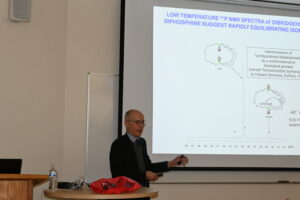
From Molecular Gyroscopes to Homeomorphic Isomerization: Molecules that Turn Themselves Inside-Out
Abstract: The Houdini-like escape of metal fragments from the cage-like dibridgehead diphosphine ligands of so-called “gyroscope-like” complexes (e.g., 1) will be described. The resulting diphosphines P((CH2)n)3P (2) can exist as in,in, out,out, and in,out isomers. The in,in and out,out isomers can interconvert by “homeomorphic isomerization” (3), a process that turns a molecule inside-out, like an article of clothing, exchanging exo and endo functionality. At temperatures sufficient for pyramidal inversion at phosphorus (ca. 150 °C), the in,in and out,out isomers equilibrate with in,out isomers. Trends in the rates and K(eq) values will be interpreted, together with a wealth of crystallographic data.

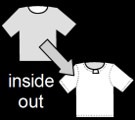
Metal complexes are easily reconstituted from the “empty” dibridgehead diphosphines 2. Ap-plications of these phenomena in the selective binding and transport of various metal fragments will be reported. The synthesis and properties of analogous diphosphine dioxides, diarsines, and di(triaryl)phosphines will also be described.
Janet Bluemel
Dr. Janet Bluemel is a Professor in the Department of Chemistry at Texas A&M University. She earned a Diploma in Chemistry (1986) and a Ph.D. in Inorganic Chemistry (1989) from the Technical University of Munich, Germany. After a postdoctoral position at the University of California, Berkeley (1989-1990) and her Habilitation in 1996 from the Technical University of Munich, she became a professor at Texas A&M University in 2007, after serving as an Associate Professor at the University of Heidelberg, Germany from 1998-2007.
Dr. Janet Bluemel has been a member of the American Chemical Society (ACS) since 1987, the German Chemical Society since 1986, and the Royal Society of Chemistry since 2005, among other prestigious societies. She has been Chair of the NMR Users Committee since 2018 and a Member of the Faculty Senate since 2016.
The Bluemel research group’s interests are in materials chemistry and published over 140 papers. They span a wide range, from organic and organometallic synthesis through catalysis and the surface chemistry of amorphous materials to solid-state NMR spectroscopy.
Professor Bluemel’s presentation was called Surface Chemistry of Immobilized and Adsorbed Molecules: Superior Catalysts and Surface-Assisted Syntheses
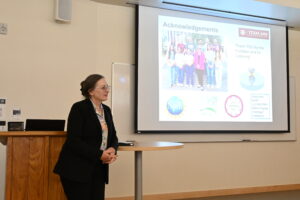
Surface Chemistry of Immobilized and Adsorbed Molecules: Superior Catalysts and Surface-Assisted Syntheses
Abstract: Surface chemistry is immensely important in industry and academia. Three different topics where the unique properties of surfaces play a crucial role will be presented: (1) Catalysts immobilized on mesoporous silica by phosphine linkers display unprecedented activities and lifetimes.1-3 (2) Surfaceadsorbed metallocenes4-8 function as precursors for single atom catalysts (SAC). (3) Surface-assisted air oxidation leads to clean phosphine oxides. 9 Solid-state NMR spectroscopy is a powerful method to study these materials using different techniques. (1) Wilkinson-type rhodium catalysts (e.g., Fig. 1) have been immobilized covalently via tripodal phosphine linkers with different chain lengths1 and characterized by HRMAS (High Resolution Magic Angle Spinning). Tripodal ligands inhibit the formation of nanoparticles, shield the metal centers from neighboring complexes and the reactive surface, and catalysts with unprecedented lifetimes are obtained.1 Tripodal linker systems can also successfully be employed for heterobimetallic catalyst systems, including the Pd/Cu Sonogashira catalyst.2,3 (2) Metallocenes such as ferrocene (Cp2Fe) and nickelocene (Cp2Ni), a SAC precursor, can be adsorbed on high surface area materials4-8 including silica (Fig. 2), 4-6 carbon nanotubes7 (Fig. 3), and activated carbon. 7,8 The quick adsorption progresses even without a solvent. The under-lying translational mobilities can be visualized, monitored, and quantified on a macroscopic scale when solid substrates migrate into the pores of large silica gel specimens (Fig. 2).6 The mobilities of the metallocenes on a surface also lead to interesting solid-state NMR phenomena.4-8 Importantly, all metallocenes form well-defined monolayers on the surface. Their reduction under mild conditions leads to single atom catalysts. (3) Surface-assisted reactions allow selective syntheses that are not possible in solution. When neat or dissolved phosphines are oxidized in air, many side-products are obtained. After adsorption on activated carbon (AC) in a monolayer, phosphines are selectively oxidized to the phosphine oxides (Fig. 4).9
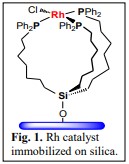
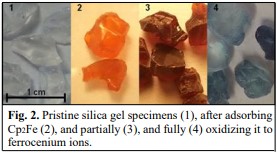
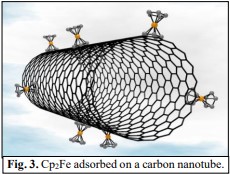
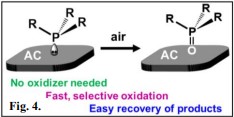
History of Robert W. Parry Lecture Speakers at the University of Utah
2023-2024
Ana de Bettencourt-Dias, University of Nevada, Reno
Luminescent complexes for imaging, therapy, and sensing
2022-2023
Joel S. Miller, University of Utah
Organic-based Magnets – New Chemistry and Materials for The 21st Century
2021-2022
Marcetta Darensbourg, Texas A&M
Inspiration for Synthetic Design from Bioorganometallic “Natural Products”: Hydrogenase and Acetyl co-A Synthase Enzyme Active Sites
2020-2021
Clifford Kubiak, University of California at San Diego
Selective Reduction of CO2 to CO In Water By Molecular Catalysts Attached To Carbon Surfaces
2019-2020
Karen Goldberg, University of Pennsylvania
Molecular Oxygen as a Reagent in Late Transition Metal Organometallic Chemistry
2018-2019
David Milstein, Weizmann Institute of Science
Design and Applications of Catalytic Reactions for Sustainable Synthesis and Energy
2017-2018
Tobin J. Marks, Northwestern University
Surface Science Meets Homogeneous Catalysis: Cooperative Properties of Electrophilic Organometallic Ensembles
2016-2017
The Inaugural Speaker of the Lecture
Professor Harry Gray, California Institute of Technology
Living with Oxygen: Metal Oxos in Chemistry and Biology
